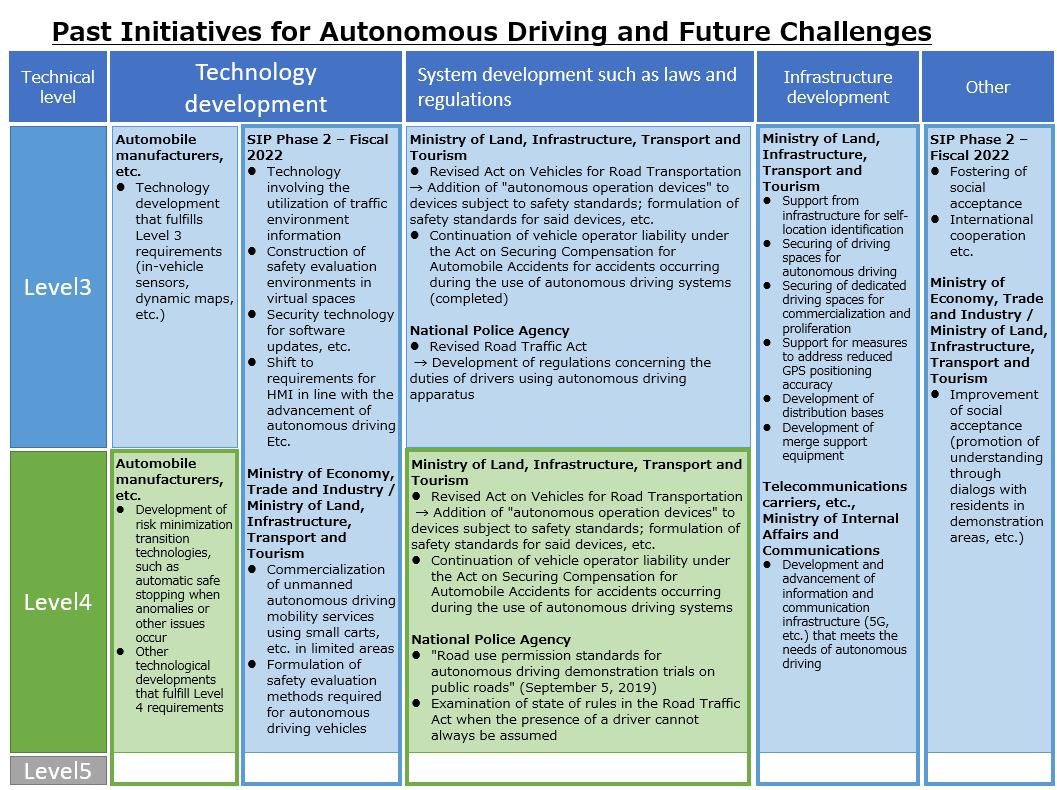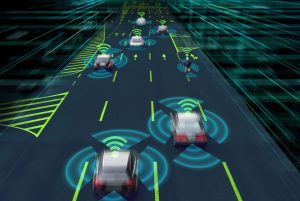Introduction
2020 was a year in which autonomous driving made great strides forward in terms of legal systems, with the establishment of related legislation in Japan to allow Level 3 autonomous driving (i.e., autonomous driving under specified conditions, with humans taking over in emergencies) on public roads and the creation of international standards concerning autonomous driving systems. Based on these advances, on November 11 Honda Motor Company’s Legend automobile became the world’s first vehicle model to obtain the authorizations required for Level 3 autonomous driving on public roads.[i]
In this article, I would like to review the state of revisions to vehicle safety standards and traffic rules for autonomous driving.
Status of the development of traffic rules
The state of international treaties concerning traffic rules have already been explained in our report “On the Front Lines of CASE – Part 4 “Autonomous Driving②” As noted in the report, the UN working group Global Forum for Road Traffic Safety (WP.1) recommended in October 2018 that member nations of the Vienna Convention on Road Traffic and the Geneva Convention on Road Traffic move forward with autonomous driving. This action empowered countries to develop domestic legislation aimed at autonomous driving.
Let us look at what sort of legislation has been developed in Japan since then.
In April 2018, the government of Japan announced the “Outline for Development of Systems Involving Autonomous Driving,” and announced a policy of developing domestic legal systems for private cars equipped with Level 3 autonomous driving systems, with the aim of practical application in 2020. According to this outline, the relevant ministries and agencies have engaged in the study of legislative development.
The Road Traffic Act, which stipulates traffic rules in Japan, falls primarily under the jurisdiction of the National Police Agency. The revised Road Traffic Law, which covers autonomous driving under specific conditions (Level 3), was enacted in April 2020 as the first legislation of its kind in the world. The main points of revision are the following three items:
(1) Definition of autonomous operation device
First, the concept of “autonomous operation devices” was put forth. This refers to autonomous driving systems that replace all of the recognition, prediction, judgment, and operation aspects of driving, with the addition of functions to record operational data.
The concept stipulates that the use of autonomous operation devices – that is, autonomous driving – is included in “driving” according to the Road Traffic Act. This enables Level 3 autonomous driving, by which the system performs operation of the vehicle within set bounds of speed and weather (i.e., under specified conditions called “Operational Design Domain (ODD)”), with the driver taking over operation in emergencies or when outside of the specified conditions.
(2) Duties of drivers
Drivers are obligated to immediately recognize any deviations from the specified conditions under which autonomous driving is possible, and to remain capable of competent operation of the vehicle.[ii]
When autonomous operation devices are used properly, holding and using a mobile phone or other device and watching the screen of a car navigation system or other device is now allowed (i.e., “secondary tasks” are no longer prohibited).
(3) Recording of operational data
For vehicles equipped with autonomous operation devices, recording and saving operational data is mandated for the purpose of confirming that vehicles are properly maintained and investigating the causes of traffic accidents.
Status of the development of safety standards
(1) Status of international standards
The autonomous operation devices noted above have been discussed at the World Forum for Harmonization of Automotive Standards (WP.29) of the United Nations Economic Commission for Europe. In June 2020, international standards were established for autonomous operation devices, cyber security, and software updates. Japan is said to have led the discussion, serving in roles including subcommittee vice chair and co-chair of expert meetings at WP.29.[iii]
The main points in the international standards are as follows:
(i) Standards concerning autonomous operation devices
- The safety achieved by the autonomous driving system should be “equal to or better than a careful and competent driver”:
While there had been past debates over whether the safety of autonomous driving systems must be perfect or should be attain roughly the level of ordinary drivers, certain standards addressing this point have now been presented. - When an alarm urging the takeover of driving has been issued, control should be continued until the driver takes over:
Transfer of control from an autonomous driving system to a driver is said to take 5 to 10 seconds. Until this transfer is completed, the system is required to properly maintain control of the vehicle.[iv] - If the driver cannot take over, the system should engage in control to minimize risk and stop the vehicle:
- The function by which an autonomous driving system safely stops the vehicle in an emergency is called “minimum risk maneuvering.” It has been considered an essential function in autonomous driving, and has now been incorporated into the international standards. Specifically, the standards assume that the system will stop the vehicle on the shoulder of the road and issue alarms to surrounding parties through sounds or lights.
- Equipping of driver monitoring to confirm that the driver is in a state capable of taking over driving:
Multiple monitoring methods are possible, including cameras and vital sign monitors. - Taking measures for ensuring cyber security to prevent unauthorized access, etc.
- Equipping with operational status recording devices that record the time when the autonomous driving system is turned on or off or when a failure occurs.
- Confirming conformity with the above requirements through a combination of simulation testing, test course testing, public road testing, and documentation.
(ii) Standards for cyber security and software updates
- Securing work management systems to ensure the appropriateness of cyber security and software updates.
- With respect to cyber security, conducting risk assessments of vehicles and appropriate handling and management of risks, and carrying out appropriate and sufficient testing to verify the effectiveness of security measures.
- Ensuring proper implementation of software updates, including prevention of dangerous/invalid software updates and advance confirmation of software update feasibility.
(2) Status of domestic legislation
In Japan, the Road Transport Vehicle Act, which falls mainly under the jurisdiction of the Ministry of Land, Infrastructure, Transport and Tourism, sets forth rules regarding vehicle safety standards. Revisions to the Act on Vehicles for Road Transportation were enacted in April 2020, together with the revised Road Traffic Act. The revisions came before the establishment of the above-mentioned international standards (June 2020).
The main points of revision are as follows:
(i) Addition of “autonomous operation devices” as a target of safety standards
As noted already, the legal definition of “autonomous operation device” was defined legally as equipment necessary to achieve autonomous driving. Such autonomous operation devices are subject to safety standards that must be cleared by automobiles, and specific safety standards have been set. The content of these safety standards is nearly the same as that set forth in the international standards noted earlier.
(ii) Management of technical information required for electronic inspections
While electronic inspections as a part of vehicle inspections had been limited to simple matters such as checking the lighting of lamps, a requirement for full-scale electronic inspections for autonomous operation devices has been created. It was decided that the technical information required for this purpose is to be managed by an incorporated administrative agency. In the future, specific inspection systems that use on-board diagnostics (OBD) will be constructed.
(iii) Expansion from “overhaul” to “specified maintenance”; provision of technical information from manufacturers to maintenance operators
Automobile maintenance, particularly in areas with a major impact on safety, has conventionally taken the form of overhaul, for which maintenance operators are required to obtain certification. The revision changes the name to “specified maintenance” in line with the expansion of the revised law’s scope via the addition of autonomous operation devices. In addition, manufacturers must provide the technical information required for inspection and maintenance to maintenance operators that perform specified maintenance.
(iv) Permission system for software updates, etc.
In the past, ex post facto modification of programs or software was not something that was assumed. A system has now been introduced by which businesses that perform updates or upgrades to programs embedded in autonomous operation devices, etc. (legally termed “specified modifications, etc.”) must obtain prior permission from the Minister of Land, Infrastructure, Transport and Tourism. These ex post facto updates may be performed wirelessly, i.e., over the air (OTA).
【Sticker indicating an autonomous driving vehicle】

In conclusion
As has been seen so far, a legal system concerning Level 3 autonomous driving has been completed to a degree, and the development of a system for Level 4 autonomous driving, with some portions set aside, is now underway as well (table below). As mentioned at the beginning, Honda Motor Company acquired model-level approval for Level 3 autonomous driving in November and announced plans to begin sales during fiscal 2020. Further actions are expected, and the situation continues to bear watching.

Source: “Public-Private ITS Initiative/Roadmap 2020” July 15, 2020
[i] Bloomberg, “Honda Legend Designated World’s First Level 3 Autonomous Driving Automobile by the Ministry of Land, Infrastructure, Transport and Tourism,” November 11, 2020, https://www.bloomberg.co.jp/news/articles/2020-11-11/QJM9Z6T1UM1R01
[ii] Road Traffic Act, Article 71-4-2, Paragraph 2, Item 3.
[iii] Ministry of Land, Infrastructure, Transport and Tourism press release materials, “International Standards for Autonomous Operation Devices (Level 3) Have Been Established for the First Time,” June 25, 2020, https://www.mlit.go.jp/report/press/jidosha07_hh_000343.html
[iv] “It takes 5 to 10 seconds to take over from autonomous driving,” Ask a BMW Autonomous Driving Expert (Part 2)
https://xtech.nikkei.com/atcl/nxt/column/18/00134/041300043/












